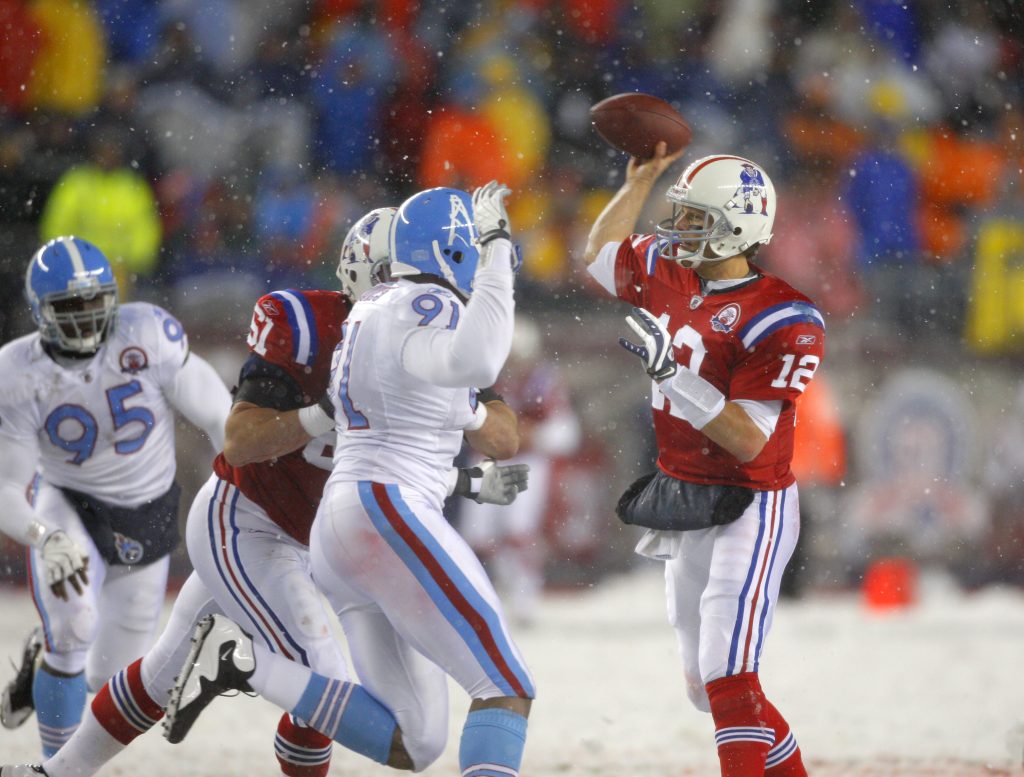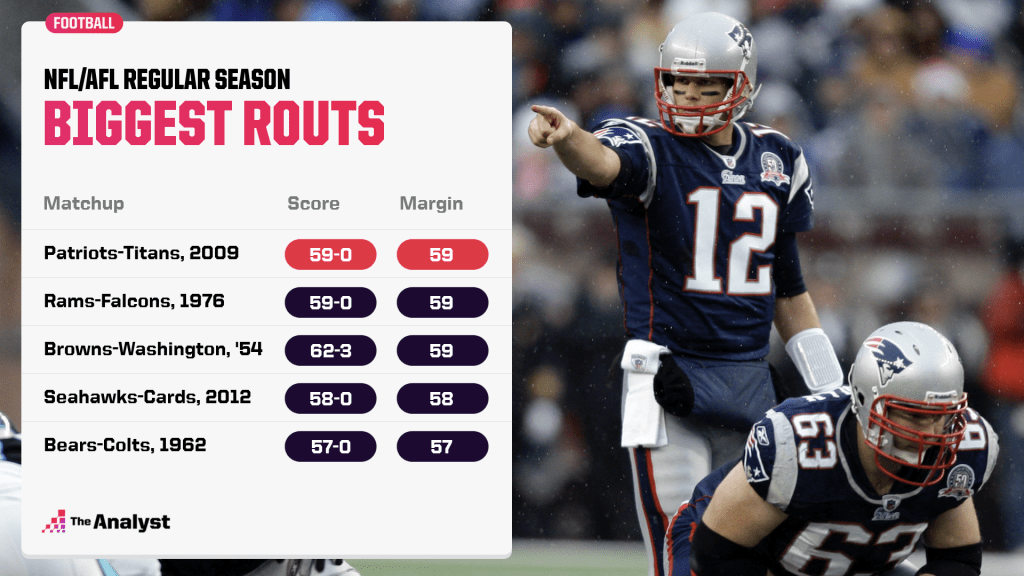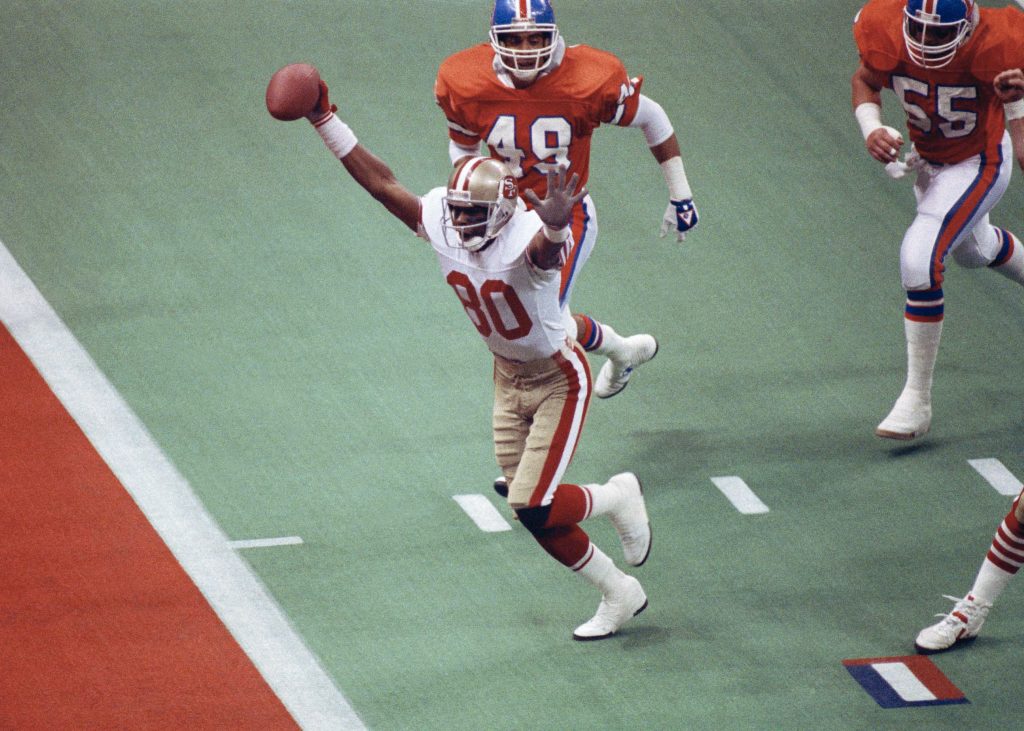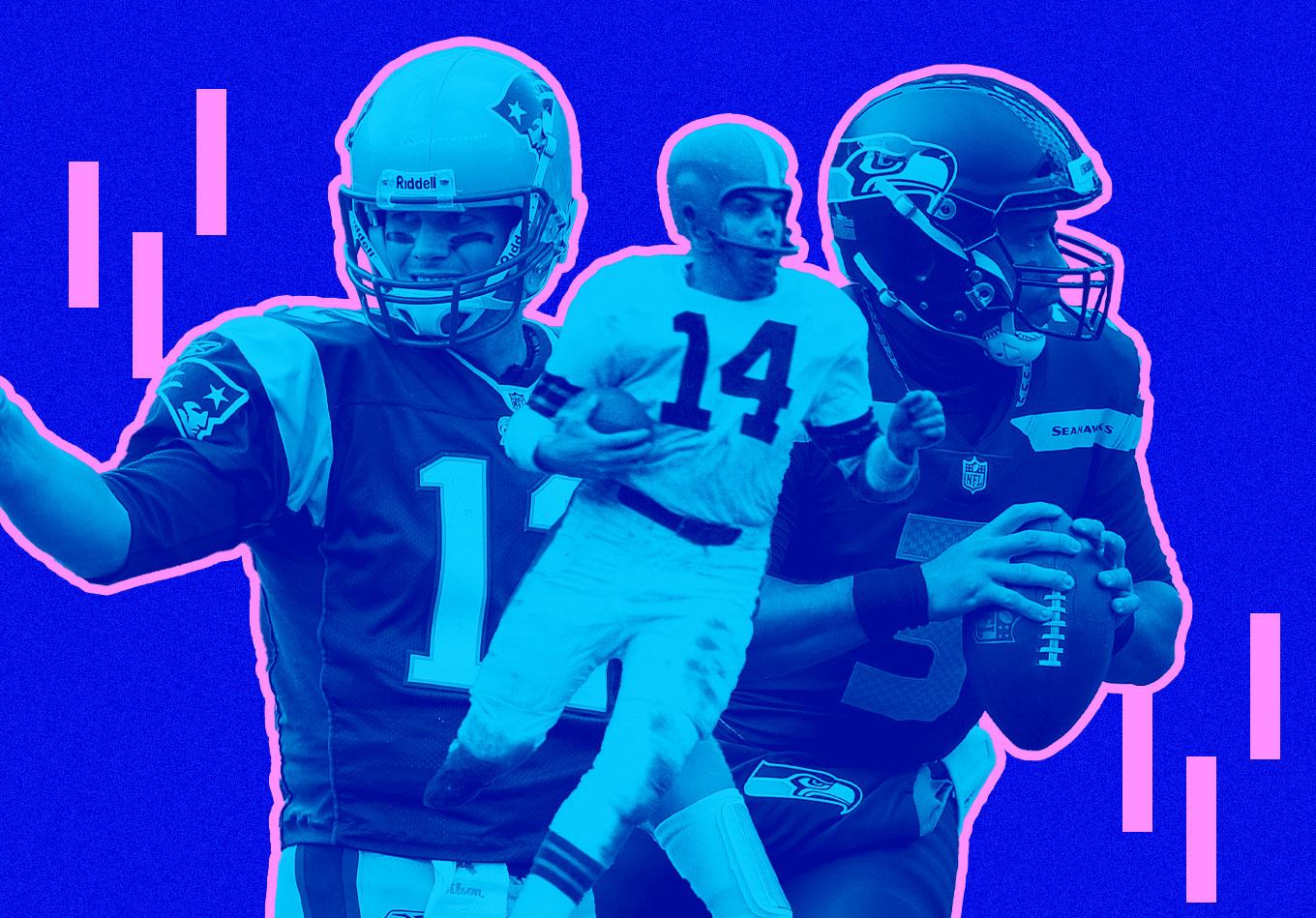Nobody likes blowouts.
Well, that’s not true. Fans of the winning team like blowouts. Fantasy managers can get behind a blowout. But casual fans? They’re switching over to a different game. And broadcasters? Proficiency in analysis gives way to a true test of small-talk skills.
Nonetheless, blowouts are a part of NFL/AFL lore. But what you may not know is that the biggest rout in league history actually took place in the playoffs (more on this later).
As far as the regular season goes, here are the most lopsided games in NFL/AFL history.
Pre-1935
There have been five games decided by 60 or more points, but they were all played before World War II and involved at least one now-defunct franchise. The biggest margin of victory in NFL history for a regular-season game is held by the Rochester Jeffersons, who beat Fort Porter, a non-league team, in 1920, winning 66-0. The largest margin of victory between two NFL teams occurred in 1934, when the Philadelphia Eagles beat the Cincinnati Reds 64-0.
OK, box checked there. We got our Rochester Jeffersons reference in. Onto the games we may recognize.
T-1. New England Patriots 59, Tennessee Titans 0; Oct. 18, 2009
After posting the league’s best record in 2008, the Titans began the 2009 regular season with five consecutive losses. Week 6 did not bring any new fortune. The Patriots scored six touchdowns in the first half, including five through the air from Tom Brady in the second quarter – an NFL record. New England would set another record – the largest lead at halftime in NFL history (45-0). In the second half, Brady led another touchdown drive to begin the third quarter before being replaced by backup and then-rookie Brian Hoyer.

Hoyer marched the offense down the field on his first drive, scoring the final touchdown of the day on a QB sneak – Hoyer’s first NFL touchdown. Tennessee turned the ball over five times and had –7 passing yards for the entire game. That’s the second-fewest passing yards in a single game since the start of the 21st century. Despite the 0-6 start, the Titans turned their season around and won eight of their final 10 games. Too bad that’s not enough to get you off a list like this.
T-1. Los Angeles Rams 59, Atlanta Falcons 0; Dec. 4, 1976
The Patriots weren’t the first team to win 59-0. In their first stint in Los Angeles, the Rams held the Falcons to just 81 total yards, including a measly 22 passing yards, and forced four turnovers. Los Angeles scored six rushing touchdowns, none coming from farther than nine yards out. Rams running back Lawrence McCutcheon, who was selected to his fourth Pro Bowl in 1976, rushed for 121 yards and three touchdowns. The only touchdown pass of the day came from backup quarterback James Harris, who found Dwight Scales for an 80-yard score. It was Scales’ only touchdown of the year, and just one of his three receptions.
T-1. Cleveland Browns 62, Washington 3; Nov. 7, 1954
In the biggest blowout in the pre-Super Bowl era, the Cleveland Browns dominated, holding Washington to just 64 total yards and forcing four turnovers. Eight different Browns carried the ball, including legendary quarterback Otto Graham, who scored a 5-yard rushing touchdown in the second quarter. Cleveland’s backup quarterback George Ratterman had a perfect 158.3 passer rating, completing 10 of 11 passes for 208 yards and three touchdowns. Even Hall of Fame kicker Lou Groza was a part of this game, connecting on two field goals and six extra points. Later that season, the Browns won the 1954 NFL championship in their third straight meeting in the season finale with the Detroit Lions. That is indeed a real sentence, correctly implying the Lions and Browns were at one time dynasty material.
4. Seattle Seahawks 58, Arizona Cardinals 0; Dec. 9, 2012
In a Week 1 road game in Arizona, the Seattle Seahawks lost to the Arizona Cardinals 20-16. Some guy named Russell Wilson made his first career start. You may have heard of him. Fast forward to Week 14, and the Cardinals are traveling up to Seattle for a rematch. The Seattle offense was taking shape with this Wilson guy under center, but not much of the damage was done through the air. Seahawks running back Marshawn Lynch rushed for 128 yards and three touchdowns on just 11 carries. Robert Turbin rushed for 108 yards on 20 carries, and Leon Washington added 38 more rushing yards and a rushing touchdown on seven carries. The Seattle defense added two defensive touchdowns – a Richard Sherman pick-six and a Malcolm Smith fumble recovery in Arizona’s end zone after a muffed punt – in a second quarter that featured four Seattle touchdowns.
5. Chicago Bears 57, Baltimore Colts 0; Nov. 25, 1962
Typically, NFL blowouts involve two vastly different teams in terms of skill level and win-loss record. But in 1962, a 6-4 Chicago Bears team, coached by the legendary George Halas, traveled to Memorial Stadium in Baltimore to meet the 5-5 Colts and, well, clobbered them. Chicago quarterback Billy Wade threw for 328 yards, while Hall of Famer Johnny Unitas threw for just 91 yards. Mike Ditka, then a tight end for the Bears, caught four passes for 40 yards, including a 5-yard score. Had they been around, Bill Swerski’s Superfans of Saturday Night Live fame would have been disappointed with Da Bears for not holding the Colts to a negative point total.

T-6. Baltimore Colts 56, Green Bay Packers 0; Nov. 2, 1958
The Colts threw five touchdown passes. The Packers turned the ball over five times. After the season, Green Bay fired Ray McLean and hired some guy named Vince Lombardi. It turned out OK.
T-6. Pittsburgh Steelers 63, New York Giants 7; Nov. 30, 1952
The teams combined for 14 turnovers, with the Giants providing nine of their own.
T-8. New Orleans Saints 62, Indianapolis Colts 7; Oct. 23, 2011
Drew Brees and the Saints completely outclassed a Peyton Manning-less Colts team in a rematch of Super Bowl XLIV.
T-8. Atlanta Falcons 62, New Orleans Saints 7; Sept. 16, 1973
The Falcons held the “Aints” to just 35 net passing yards and forced eight turnovers.
T-8. Houston Oilers 55, Oakland Raiders 0; Sept. 9, 1961
The Raiders gained just 99 total yards. Later that season, the Oilers would dominate again, beating Oakland 47-16. You take the good with the bad, but again, the good doesn’t wipe the bad from cold-hearted lists such as this.
Biggest Blowout in Playoff History (Pre-Super Bowl Era): Chicago Bears 73, Washington 0; Dec. 8, 1940
This was the biggest rout of them all. The 73-point margin still marks the most lopsided game in NFL/AFL history. Though both teams entered with identical 9-3 records, the Bears scored a touchdown in every quarter, including three in the first, four in the third and three more in the fourth. Three different players (Bill Osmanski, Joe Maniaci and Harry Clarke) had touchdown runs of at least 40 yards. In the third quarter, three different Chicago defenders returned interceptions for touchdowns, including one each from the fantastically named Hampton Pool and Bulldog Turner. Those three interceptions were part of nine takeaways for the Bears’ defense. They also averaged 7.2 yards per carry, totaling 381 yards on the ground. Chicago won four titles that decade, with Halas guiding the team to three of them, furthering establishing the Bears as one of the greatest team-coach pairings in league history.
Biggest Blowout in Playoff History (Super Bowl Era): Jacksonville Jaguars 62, Miami Dolphins 7; Jan. 15, 2000
Not only is this 2000 AFC Divisional Round matchup the biggest blowout in NFL playoff history, but it also marked the final game of Dolphins’ Hall of Fame quarterback Dan Marino’s illustrious playing career. This was ugly right out of the gate. The Jaguars, the AFC’s top seed that season, scored 24 points in the first quarter, including a 90-yard touchdown run from Fred Taylor. Jacksonville scored 38 points and put in their backup quarterback, Jay Fiedler (who, coincidentally, would take over Miami’s starting job the following season), before Marino completed his first pass of the game. The Dolphins committed seven turnovers, including four from Marino (two interceptions and two fumbles lost). Jacksonville rushed for 257 yards; Miami rushed for 21. The Jaguars would advance to the AFC Championship Game, only to fall short of the Super Bowl, losing 33-14 to their division foes, the Tennessee Titans.
Biggest Blowout in Super Bowl History: San Francisco 49ers 55, Denver Broncos 10; Super Bowl XXIV, Jan. 28, 1990
Ah, the Super Bowl. The annual game pitting the best team from each of the NFL’s conferences. Destined to be a classic every year, right? Well, not exactly. There was a time in the NFL when AFC teams just couldn’t keep up and lost 13 straight Super Bowls. This was peak NFC dominance. The 49ers entered as heavy favorites (-12), and they delivered. Joe Montana and Jerry Rice – you may have heard of them as well – connected seven times for 148 yards and three touchdowns.

Montana threw for 297 yards and five touchdowns, compiling a passer rating of 147.3 – the second-highest passer rating in Super Bowl history. And this was all against the best defense in the league, as Denver held the league to the fewest yards and points per game in 1989. Even Broncos legend John Elway couldn’t save his team. His 19.4 passer rating is the third lowest in Super Bowl history. But hey, in 1997, Elway ended the NFC’s Super Bowl streak.
There are two sides to every blowout. Hopefully your team came out of these untarnished.
Enjoy this? Subscribe to our mailing list to receive exclusive weekly content.
Research support provided by Tim Abel.
